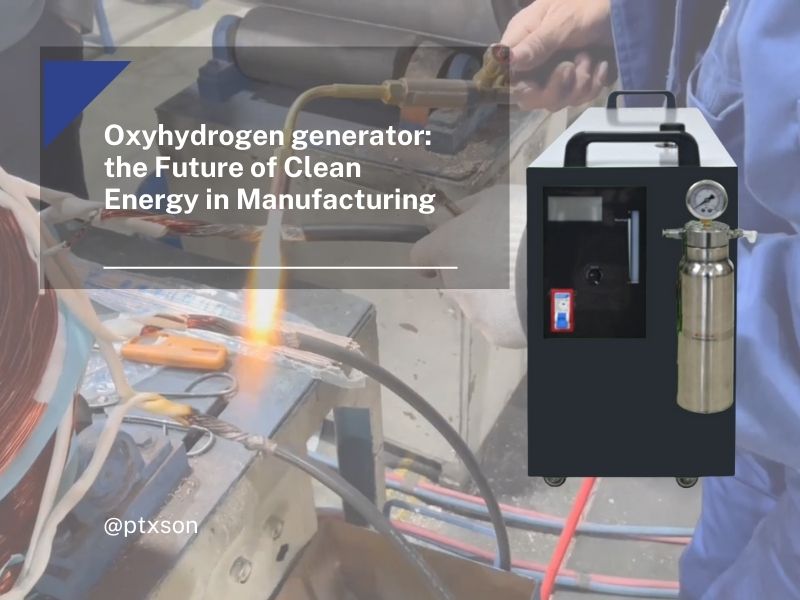Oxyhydrogen generators work by electrolyzing water (H2O) into hydrogen (H2) and oxygen (O2) via an electric current. The device’s working medium is an electrolyte solution, usually water mixed with an electrolyte like potassium hydroxide (KOH) or sodium hydroxide (NaOH), to improve conductivity and high gas production efficiency. The produced oxyhydrogen gas is then directed to oxy-hydrogen welding torch or combustion chamber. The combustion process of oxyhydrogen is different from that of traditional fuels like natural gas and propane due to the nature of the gases. Oxyhydrogen, a mixture of hydrogen (H2) and oxygen (O2), produces only water vapor when ignited. This results in a clean, high-temperature oxyhydrogen flame with no harmful emissions, such as carbon dioxide or soot, which are common in the combustion of fossil fuels like natural gas and propane.
In contrast, the combustion of natural gas and propane results in the release of carbon dioxide (CO2), water vapor, and other pollutants, contributing to greenhouse gas emissions and environmental pollution. What’s more, the combustion process of traditional fuels produces a cooler flame compared to the intense heat of hydrogen flame temperatures up to 2,800°C. This higher temperature makes oxyhydrogen generators highly effective for precision processes in industrial applications, such as welding and cutting, where clean and efficient combustion is crucial.Overall, the use of oxyhydrogen generators not only reduces environmental impact but also enhances the efficiency and safety of industrial manufacturing.
Environmental Benefits of Using Oxyhydrogen Gas Generator
Oxyhydrogen gas generator is a cleaner alternative to traditional fossil fuels, producing only water vapor when burned. This means zero carbon emissions, which helps reduce greenhouse gases and lowers the environmental impact of industrial processes. Unlike propane or natural gas, which release carbon dioxide and other pollutants, oxyhydrogen generator helps purify the air and create a healthier environment.
Oxyhydrogen Generators in Sustainable Manufacturing Process
In the background of sustainable manufacturing, oxyhydrogen generators play a key role in the eco-friendly practices. Industries that adopt oxyhydrogen technology can significantly reduce their reliance on non-renewable energy sources, thereby aligning with global sustainability goals. For example, in processes of welding, cutting, and brazing, oxyhydrogen generator offers a cleaner alternative to acetylene or propane, reducing carbon emissions and ensuring a safer working environment.
The high oxy-hydrogen combustion temperature allows for more precise and efficient manufacturing processes, reducing waste and improving the quality of the products. Additionally, since oxyhydrogen gas is produced from water, it supports a circular economy model where resources are utilized more efficiently and sustainably.
Efficiency of Oxyhydrogen Generators vs. Traditional Fuel System
Oxyhydrogen generators have significant efficiency advantages over traditional fuel. The main difference lies in the combustion process. Oxyhydrogen generators produce a pure mixture of hydrogen-oxygen gas that burns at a much higher temperature than traditional fuels such as propane or natural gas. This intense heat enables more precise and efficient energy use, especially in industrial applications of welding, cutting, and brazing. The clean combustion process also means more efficient energy use, with minimal energy loss due to incomplete combustion or the production of unwanted byproducts.
On the other hand,traditional fuel systems often burn inefficiently because they produce not only energy but also carbon dioxide, soot and other pollutants. These byproducts not only waste energy but also require additional resources for treatment and mitigation, further reducing overall efficiency.
Long-Term Cost Benefits of Using Oxyhydrogen Generators
The long-term cost benefits of oxyhydrogen generators are very significant, especially when considering the reduction in fuel costs, maintenance and environmental impact. Since oxyhydrogen generators use water as the main fuel source, the cost of producing hydrogen and oxygen is significantly lower than purchasing and storing gas cylinders such as propane or natural gas. In the long running, this can result in considerable energy savings, especially for industries with high fuel consumption.
In addition, the clean combustion process of the hydrogen-oxygen generator reduces equipment wear, lowers maintenance costs and extends the service life of industrial machinery. Traditional fuels produce soot and other residues that often require more frequent maintenance and cleaning, resulting in higher operating costs.
Moreover, the environmental benefits of oxyhydrogen generators can translate into financial incentives, such as tax credits or subsidies for using clean energy technologies. As the industry increasingly focuses on sustainability, adopting hydrogen-oxygen generators can also enhance a company’s reputation, potentially increasing business opportunities and customer loyalty.
Overall, switching to hydrogen-oxygen generators not only improves efficiency but also provides significant long-term cost savings, making it an attractive option for modern sustainable industrial practices.
Industrial Applications of Oxyhydrogen Generators
Oxyhydrogen generators are most commonly used in industries where precision and quality are critical, such as welding, casting, and metalworking. During the welding process, the high-temperature flame produced by oxyhydrogen ensures a clean, strong joint with minimal oxidation and slag, resulting in superior weld quality. This precision is critical in industries such as automotive manufacturing, aerospace, and electronics, where even tiny defects can cause serious problems.

In casting processes, oxyhydrogen generators are used to create cleaner, more detailed molds by eliminating carbon residue and other contaminants that can compromise the final product’s integrity. The high purity and controlled temperature of the oxyhydrogen flame enables manufacturers to achieve complex designs with greater precision, improving the quality of the casting.By improving the precision and cleanliness of these industrial processes, oxyhydrogen generators help industry produce higher quality products while reducing waste and rework, ultimately increasing production efficiency and cost-effectiveness.